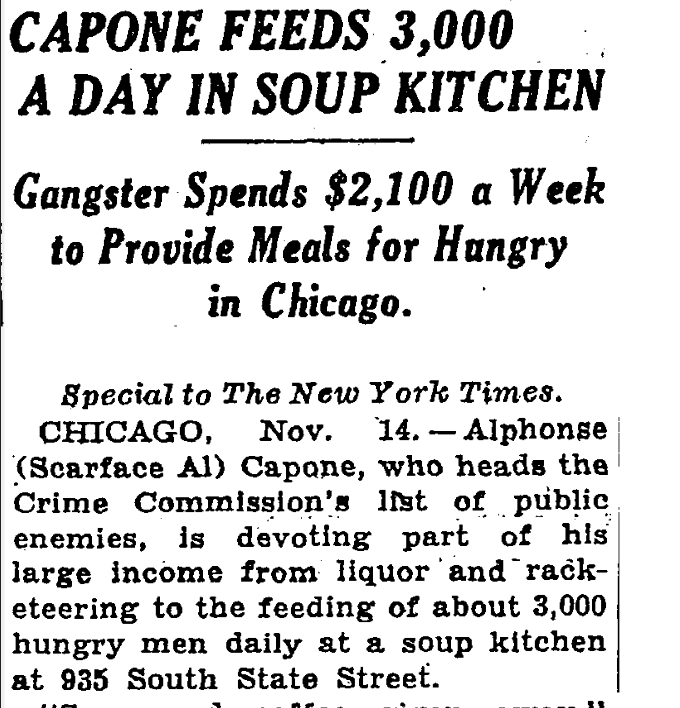Al Capone’s Soup Kitchen: Oddities of the Great Depression
Living in a worldwide pandemic where toilet paper is hoarded, and awkward elbow bumps have replaced traditional greetings, it isn’t too far-fetched to see how the Great Depression turned the world on its head. The Great Depression was a worldwide phenomenon, a time when a gangster was dubbed “angel,” and hope shined through deprivation.
Given the current state of the world, it may be helpful to look at the theories surrounding what caused the great depression and what finally lifted the US from its dispossession.
Causes of the Great Depression
Ben S. Bernake notes that one of the major causes of the great depression was the financial collapse. The start of this economic collapse is often seen in the growing speculation of the 1920s culminating in the dreaded “Black Tuesday.”
The stock market crash of October 24, 1929, resulted in over 12 million shares traded in one day. This crash led to panic where five days later, on “Black Tuesday,” a record 16.4 million “shares changed hands.”


If wild speculation and the ultimate POP of the market wasn’t enough, severe weather colluded with fate to turn the tide of prosperity in North America. The “Dust Bowl” period of the 1930s destroyed farms and agriculture across the States and into Canada. This destruction led many to flee to the cities for food and shelter.
In light of these tragedies, one may expect to find a state of melancholy in this depression. In contrast, while renowned photographer Dorothea Lange, and others, did capture some downtrodden people; many of their images reveal HOPE and genuine joy.




As peculiar as it may seem to behold the inner hope of those who lived through the great depression, it may be just as surprising to read The Baltimore Sun name Al Capone the “Angel of [the] Soup Kitchen.” Furthermore, one New York Times article notes that Capone spent over $2,000 a week to feed the hungry.


While resilience and surprising generosity were found in the great depression, it was also a time of great suffering. So, what ultimately ended America’s great depression?
Saving Factors: Rival Theories
Some economists, such as Christina D. Romer, following the Keynesian theory argue that President Franklin D. Roosevelt saved America from the great depression by pumping money into the economy and issuing “the New Deal” program; others disagree.

Hugh Rockoff notes that “Keynesian economists, convinced a generation of American intellectuals that only socialism (or near-socialism) could save the American economy from periodic economic meltdowns.” Opposite of the socialistic approach, the Milton Friedman and Anna Schwartz methodology suggests a free-market economy with less government interference is what normalized the country.
Building on the Friedman-Schwartz theory, Bernake notes that the only part of the New Deal program that promoted recovery to the economy was the “federally directed financial rehabilitation” (272). Yet, he adds that this aid was ‘neither rapid nor complete.”
Economist Stephen Moore writes that it wasn’t until after WWII that the great depression indeed lifted. Under President Harry Truman, there was a massive reduction in governmental spending, states Moore, and an increase in the free-market economy. People who had to save during the war were now able to produce products and spend their money freely.
While the theories of what stopped the great depression are at odds, they are still very much at play today. One can see them at work in the United States COVID-19 climate. With government stimulus checks in the Keynesian corner and those arguing to keep businesses open with no lockdowns in the other. Thankfully, in the midst of the confusion, there is also hope and surprising generosity all around.
References:
Primary
“Al Capone Feeds Chicago’s Jobless: Racketeer King Revealed As “Angel” Of Soup Kitchen for City’s Hungry.” The Sun (1837-), Nov 15, 1930. 1, ProQuest Historical Newspapers.
“Chronology Of Outstanding Financial Events During 1929” New York Times (1923-), Dec 31, 1929. 32, ProQuest Historical Newspaper
“Capone Feeds 3,000 A Day in Soup Kitchen: Gangster Spends $2,100 A Week to Provide Meals for Hungry in Chicago.” New York Times (1923-), Nov 15, 1930. 4, ProQuest Historical Newspapers.
“Chronology Of Outstanding Financial Events During 1929” New York Times (1923-), Dec 31, 1929. 32, ProQuest Historical Newspaper
Secondary
Bernanke, Ben S. “Nonmonetary Effects of the Financial Crisis in the Propagation of the Great Depression.” The American Economic Review 73, no. 3 (1983): 257–76. http://www.jstor.org/stable/1808111.
Moore, Stephen. “What Really Ended the Great Depression?’ https://www.heritage.org/trade/commentary/what-really-ended-the-great-depression
Rockoff, Hugh. Review of A Monetary History of the United States, 1867-1960 by Milton Friedman and Anna Jacobson Schwartz. Princeton: Princeton University Press, 1963. Economic History Association, EH.net.
Romer, Christina D. “What Ended the Great Depression?” The Journal of Economic History 52, no. 4 (1992): 757–84. http://www.jstor.org/stable/2123226.
All Images from: Encyclopædia Britannica ImageQuest.






